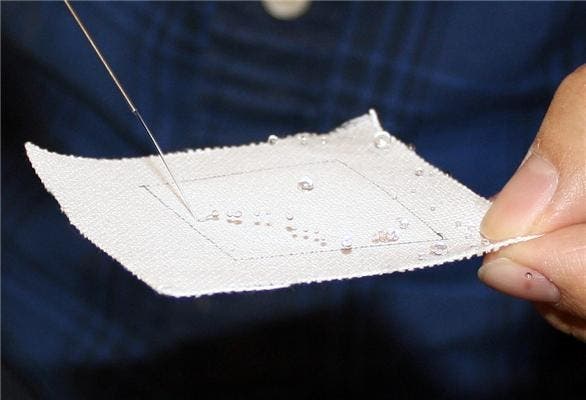Summer’s just around the corner, for those of us living in the northern hemisphere at least, and while we’ve been yearning for it all winter long, the scorching noon heat wave is here to remind us that summer’s not all fun and games. If you’re a commuter, then most likely summer’s your biggest worst enemy – dozens of sweaty people wrapping you from all fronts in the transit bus is a most scary sight. Let’s be honest, you don’t smell much better in these conditions either.

For years, scientists have been trying to develop various solutions to tackle sweat, and a recently developed waterproof fabric by researchers at UC Davis looks extremely promising. The fabric can effectively collect sweat through the side that comes in contact with the skin, and then expel it through the other side at the fabric’s surface, thanks to an ingenious use of microfluid technology.
A few words on sweat, first. It’s important to note that sweat is actually one of your most important bodily functions. People, and most animals, sweat all the time, despite this might go unnoticed. This is our body’s way of dispersing body heat that comes from our metabolism and working muscles. Sweat can occur in response to a stressful situation, heat, or exercise.
The new textile microfluidic platform was developed by graduate students Jia Jiang and Siyuan Xing, supervised by Tingrui Pan, professor of biomedical engineering at Pan’s Micro-Nano Innovations Laboratory at UC Davis. The fabric’s design is extremely ingenious, being made out of hydrophilic (water attracting) threads that were stitched into an extremely-water repellent fabric. This pattern collects water, sweat or any similar fluid from one end of the fabric and pushes them along the threads and finally ejected them from the other side. What’s important to note is that the process and fabrics themselves aren’t at all complicated and can be scaled and employed by manufacturing processes already in place.
“We intentionally did not use any fancy microfabrication techniques so it is compatible with the textile manufacturing process and very easy to scale up,” said Xing, lead graduate student on the project.
It’s not just that the threads conduct water through capillary action. The water-repellent properties of the surrounding fabric also help drive water down the channels. In fact, the fabric’s action is resembled by the researchers with human skin, forming excess sweat into droplets that drain away by themselves. Check it out in action in the video below:
The fabric’s design shines through its water-repellent properties that drive water down the channels embedded through the fabric. Unlike conventional fabrics, the water-pumping effect keeps working even when the water-conducting fibers are completely saturated, because of the sustaining pressure gradient generated by the surface tension of droplets.
The rest of the fabric stays completely dry and breathable. By adjusting the pattern of water-conducting fibers and how they are stitched on each side of the fabric, the researchers can control where sweat is collected and where it drains away on the outside.
Athletes, workout enthusiasts, as well as casual people seeking to battle sweat alike, will definitely rejoice at this news. Hopefully the fabric will see production soon enough, within a few years.
The findings were reported in the journal Lab on a Chip.


